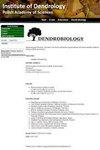Modifying stomatal conductance delays dehydration but not postharvest needle abscission in Abies balsamea
IF 1.8
4区 农林科学
Q2 FORESTRY
引用次数: 0
Abstract
Postharvest needle abscission poses a significant challenge to the balsam fir (Abies balsamea L.) Christmas tree industry. Root detachment, and other postharvest handling and transporting factors, lead to a progressive dehydration leading to postharvest needle loss. If this were so, reducing the transpiratory water loss through regulating stomata would be expected to reduce dehydration extending needle retention. This study explored this hypothesis through manipulation of balsam fir stomata using chemical treatments to determine the effect on water uptake, relative water content, and needle abscission. Branches were collected from 70 trees and immediately applied a postharvest treatment of water (control), ABA, fluoridone, BAP, theophylline, potassium nitrate, or dopamine. Stomatal conductance decreased by 27% after application of ABA and increased by 24%, 17%, and 18% by fluoridone, BA, and potassium nitrate, respectively. Consequently, the ABA treatment resulted in a significantly lower water uptake while fluoridone, BAP, and potassium nitrate all increased water uptake. Despite changes in stomatal conductance and water uptake, there were no significant changes in needle retention. Needle abscission commenced after an average of 12.5 days from postharvest treatment application and reached 100% completion after an average of 71.9 days. It is possible to manipulate stomatal conductance and water uptake through chemical methods, but such a manipulation does not guarantee superior needle retention. It is proposed that deficiency of certain hormonal signals originating from roots may play a critical role in postharvest needle abscission.改变气孔导度可以延缓冷杉的脱水,但不能延缓采后针尖脱落
采后针叶脱落对香脂冷杉圣诞树产业构成了重大挑战。根脱落和其他采后处理和运输因素会导致逐渐脱水,导致采后针头丢失。如果是这样的话,通过调节气孔减少蒸腾性水分损失将有望减少脱水,延长针头滞留时间。本研究通过化学处理对香脂冷杉气孔的处理来确定对水分吸收、相对含水量和针叶脱落的影响,从而探索了这一假设。从70棵树上采集枝条,并立即在采后处理水(对照)、ABA、氟酮、BAP、茶碱、硝酸钾或多巴胺。施用ABA后,气孔导度下降了27%,施用氟酮、BA和硝酸钾分别提高了24%、17%和18%。因此,ABA处理显著降低了水分吸收,而氟酮、BAP和硝酸钾都增加了水分吸收。尽管气孔导度和水分吸收发生了变化,但持针率没有显著变化。采后处理施用后平均12.5天后开始脱针,平均71.9天后达到100%脱针。通过化学方法可以控制气孔导度和水分吸收,但这种操作不能保证良好的持针性。研究表明,来源于根的某些激素信号的缺乏可能在采后针叶脱落中起着关键作用。
本文章由计算机程序翻译,如有差异,请以英文原文为准。
求助全文
约1分钟内获得全文
求助全文
来源期刊

Dendrobiology
农林科学-林学
CiteScore
2.20
自引率
11.10%
发文量
17
审稿时长
>12 weeks
期刊介绍:
Dendrobiology publishes original research articles and review articles related to the biology of trees and shrubs.
 求助内容:
求助内容: 应助结果提醒方式:
应助结果提醒方式:


